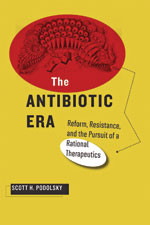
Johns Hopkins UniversityEst. 1876
America’s First Research University
Now Browsing:
Antibiotic Resistance and a National Action Plan
Guest post by Scott H. Podolsky, MD

Antibiotic resistance has been framed by Dame Sally Davies, the Chief Medical Officer for England, as “a ticking time bomb . . . arguably as important as climate change for the world.” Responding to the issue, on March 27th, President Obama’s Task Force for Combating Antibiotic-Resistant Bacteria released its National Action Plan. This is not the first time that reformers have called for a crusade to implement the rational use of antibiotics, or to keep up with antibiotic resistance. History shows that merely surfacing the issues around antibiotic resistance doesn’t ensure the will and funding necessary to enact a solution to the problem.
Antibiotics were the leading representatives of the post-World War II wonder drug revolution. They radically transformed medical practice, underpinning advancements ranging from chemotherapy to critical care medicine, but they simultaneously altered the expectations of patients with lesser (and indeed, unresponsive) conditions like head colds. And from the 1950s onward, leading infectious disease experts called for novel diagnostic resources to differentiate bacterial from viral infections, at the same time lamenting the seemingly irrational therapeutic exuberance of clinicians on the front lines. Already in 1954, the chief of the medical service at the Franklin Delano Roosevelt Veterans Administration Hospital in New York called for a “crusade for the rational use of antibiotics,” pointing to such concerns as allergic reactions, financial costs, bacterial or fungal superinfections, and the general diagnostic sloppiness that seemed to accompany widespread antibiotic administration. But by the 1960s and 1970s, as attention increasingly focused on antibiotic resistance genes that seemed to respect neither bacterial species nor nation-state boundaries, such antibiotic resistance came to serve as the focus of antibiotic reform efforts.
Calls to improve stewardship and link the local and global surveillance of resistant microbes increased from the 1970s onward, joining calls to curtail the use of antibiotics in agriculture, where they had been used to promote growth since the 1950s. For decades, though, advocates for antibiotic resistance failed to catalyze enduring reform, bumping up against faith in therapeutic progress, failed attempts to influence clinician prescribing patterns, and the lack of a centrally coordinated—let alone global—approach to the problem.
But by the 1980s and 1990s, more attention was being given to multidrug-resistant bacteria, and HIV/AIDS focused attention on emerging infections. In this context, scientists such as Stuart Levy and Joshua Lederberg began to agitate for a better coordinated and global response to antibiotic resistance. Such activities indeed proved catalytic, forcing antibiotic resistance onto the front pages of academic journals and popular media alike, eventually spreading terms like “superbugs” and “post-antibiotic era” throughout popular discourse. In ensuing decades, however, concerns have only increased in the setting of increasing globalization, a perceived reversal of pharmaceutical industry engagement with infectious diseases, and the enduring lack of a globally coordinated response to surveillance and use of antibiotics in clinical practice and agriculture.
The President’s National Action Plan appears at a critical time. It takes a broad approach, focused on efforts to improve surveillance, diagnostics, and stewardship, to rationalize the use of antibiotics in agriculture, to stimulate the development of novel antibiotics, and to improve global cooperation in confronting antibiotic resistance. And it should be politically neutral. In 1968, Joshua Lederberg, who would come to play such a key role in moving antibiotic resistance onto the national radar, reported on (and named) the newly identified Marburg virus (ultimately found to be related to Ebola), stating of such global “evils” that they were “very unlikely to discriminate between Democrat or Communist or Maoist.” Antibiotic-resistant superbugs will hardly discriminate between Democrats and Republicans. Advancing the Action Plan from paper to a coordinated response commensurate with the scope of the problem will require financial, logistical, and political investments—and collaboration—beginning in the United States, at the same time that we attempt to engage antibiotic resistance on a global level.
Scott H. Podolsky is an internist at Massachusetts General Hospital, an associate professor of global health and social medicine at Harvard Medical School, and the director of the Center for the History of Medicine at the Francis A. Countway Library of Medicine. He is the author of The Antibiotic Era: Reform, Resistance, and the Pursuit of a Rational Therapeutics and Pneumonia Before Antibiotics: Therapeutic Evolution and Evaluation in Twentieth-Century America.

Login to View & Leave Comments
Login to View & Leave Comments


